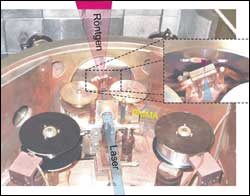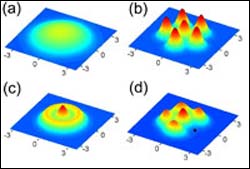Physics and Astronomy
This area deals with the fundamental laws and building blocks of nature and how they interact, the properties and the behavior of matter, and research into space and time and their structures.
innovations-report provides in-depth reports and articles on subjects such as astrophysics, laser technologies, nuclear, quantum, particle and solid-state physics, nanotechnologies, planetary research and findings (Mars, Venus) and developments related to the Hubble Telescope.

Control circuit for future supercomputer to be produced in Finland
The circuit will improve the computational accuracy and efficiency of quantum computers operating at extremely low temperatures.
Quantum computers require an ambient temperature of approximately -273 degrees centigrade to function properly. The Technical Research Centre of Finland (VTT) is to build a control circuit for such a superconducting computer that will function at very low temperatures. Future quantum computers will be able to crack IT encryption codes and perform searche

Non Fire Yet But The Sensors Snap Into Action
Russian researchers offer a fundamentally new approach to the development of gas sensors for fire-prevention detecting devices. In contrast to already known ones, these sensors allow to detect unerringly fire occurrence at its earliest stage. However, this is not a single advantage of the innovation or a sole field of application.
Moscow scientists – specialists of the Institute of Molecular Physics (Russian Research Center) “Kurchatov Institute” have managed to teach fire-preven

Purdue method to help engineers design systems for Mars, moon missions
Purdue University researchers, in the culmination of a four-year NASA-funded project, have created a method that will enable engineers to design more efficient systems for heating, cooling and other applications in spacecraft for missions to Mars and the moon.
The new method uses a model that was recently shown to be highly accurate in experiments onboard a NASA KC-135 aircraft that creates reduced gravity conditions such as those in earth orbit, on the moon and Mars. The air

Second space Christmas for ESA: Huygens to begin its final journey to Titan
One year after Mars Express’ arrival at Mars, the mighty rules of celestial mechanics have again set Christmas as the date for a major ESA event in deep space.
At 1.25 billion km from Earth, after a 7-year journey through the Solar system, ESA’s Huygens probe is about to separate from the Cassini orbiter to enter a ballistic trajectory toward Titan, the largest and most mysterious moon of Saturn, in order to dive into its atmosphere on 14 January. This will be the first man-made obj

Swinging Atoms – ultrashort flash of x-rays images atomic motions
In the current issue of Science magazine (Vol. 306, Dec. 3, 2004), scientists from the Max-Born-Institute for Nonlinear Optics and Short Pulse Spectroscopy (MBI) in Berlin, Germany, report the direct observation of atomic motions in a semiconductor nanostructure. They use a novel, laser-driven source for ultrashort x-ray pulses to take a movie of atomic motions in a semiconductor nanostructure. “We can observe changes on ultrashort timescales with our femtosecond x-ray diffraction setup”, says

Bosons crystallize in 2-D traps
Researchers at the Georgia Institute of Technology have unveiled a fundamental change in the properties of matter. The theoretical finding, that bosons placed in two-dimensional harmonic traps will crystallize when the strength of their repulsive interactions is increased, appears in the December 3 issue of the journal Physical Review Letters (volume 93, article 230405, 2004).
One of two categories of elementary particles, bosons typically form cloudy aggregates called Bose-E